Camry down from three to one
/Low demand for sedans has kiboshed all but the flagship grade, but Toyota is proposing this as a plus.
Read MoreLow demand for sedans has kiboshed all but the flagship grade, but Toyota is proposing this as a plus.
Read MoreToyota NZ lips are still zipped about the freshen that is drawing worldwide attention - but they’ve shared a photo of the car ahead of the official unveil.
Read MoreNZ-market model caught up in Japan’s admission of improper certification. (This story replaces an earlier report).
Read MoreToyota NZ sustainability report releases as parent signals new ‘Green’ identifier.
Read MoreFORWARD orders for new Toyota and Lexus models have reached 11,000 unites, effectively six months’ sales, and buyers are generally in for prolonged wait times.
An unprecedented accrual for Toyota New Zealand affects every model it represents, general manager of new car sales Steve Prangnell says, including one still to come, the next version of a traditional big seller, the Toyota Highlander.
Read More
MIGHT an incoming high-set crossover version of the new Yaris so overshadow the orthodox models arriving now as to endanger their ongoing showroom presence?
The possibility of this has been acknowledged by the brand’s national boss.
“I believe over the next 12 to 18 months that Yaris Cross will be the Yaris hatch replacement,” says Toyota New Zealand’s newly-installed chief executive, Neeraj Lala, in speaking to changing trends in the light car category.
“Given the trends in the market and given that this car (the Cross) has such high appeal to a slightly older demographic, I think the Yaris Cross will be the dominant small car for us.

the yaris cross is about six weeks from release.
“What that means for Yaris hatchback moving forward we will wait and see.”
Though it has never been able to emulate the volumes achieved by Toyota’s most popular car, the Corolla, Yaris has traded as a solid performer across three preceding generations, though registrations have diminished in the past two years, from 2002 in 2018 to 1802 last year.
The light car sector still achieves around 10,000 to 11,000 units per year for an 11 percent share of new car sales, according to Toyota NZ. Yet the market leader’s optimism about where is going seems greater than general industry sentiment. Many brands have struggled and core historic rival, Ford, has become so disillusioned as to pull mainstream editions of the Fiesta and instead pin all hope on a performance ST.
TNZ’s ongoing positivity seems driven in large part because it is strengthening its private buyer business and now has a hybrid drivetrain.
Yet it is also acknowledging change in consumer taste. Hence why the Yaris Cross is just weeks away from introduction.

TNZ has yet to fully unwrap its plans for this derivative, but as a spin-off design off the same engineering and design base as the pathfinder hatchbacks it could well also fully replicate the hatchback line which comprises four 1.5-litre petrols, all driving through CVTs, two with a hybrid drivetrain, and in GX and ZR specification grades.
Being taller and with greater ground clearance than the donor – though only for show (no additional off-seal competence is claimed) – the Cross will potentially have a premium over the hatches, which range from $25,990 to $32,990, unless a special paint finish is chosen. That adds $500.
A crossover is just one new direction for Yaris – it is also set to configure here as a fully hot hatch by year-end.
Inspiration for the wild 192kW/360Nm four-wheel-drive turbocharged GR (for Gazoo Racing) car comes from Toyota’s entry in the wavering World Rally Championship and is also fired by the brand’s determination to rev up its showroom image.
The GR will be the basis for a replacement for the Yaris that currently competes in WRC and would assuredly have been seen in action here in September had not our round been skittled by coronavirus.
Interestingly, the brand has already started the GR push in Japan with a curious concoct called the RS. This delivers the same imposing wide-hipped body, bespoke aero package, twin exhaust outlets and ultra-wide stance of the full-fat GR but runs the mainstream petrol engine. There’s no talk of it coming here.

TNZ has already taken 20 firm orders for the GR and says this interest has been enough to persuade Japan to provision more than the five units it originally earmarked for NZ for this year.
TNZ’s enthusiasm for the additional family members notwithstanding, it also sees interest in the Yaris as it presents just now being re-energised.
The model going to a fresh platform promising better driving feel, a lift in safety equipment and the hybrid’s efficiency have been cited as factors expected to raise the car’s game and status.
The latter might seem of especial interest, though the tech has taken its sweet time getting here. While this is the first hybrid Yaris available new here, it’s actually the third Toyota has created: The predecessors were based on the gen three car that NZ took from 2011; the first went into production in 2012 then was radically re-engineered four years on. However, it was only ever available in certain markets, none at this end of the world.
This latest one looks a lot more convincing than the predecessors, even though the pure electric operability is as limited as on any other Toyota hybrid – basically, the battery-only impetus avails at start-up, in reverse and at very low speed, for very limited duration, moving forward. In keeping with the Toyota/Lexus hybrid culture, it of course also lacks capability for plug-in replenishment, a feature required to establish connection as an electric car.

Yaris misses out on claiming as the country’s cheapest battery-assisted new passenger product - that title being recently snared by the Suzuki Swift hybrid.
Yet it certainly stakes a strong claim for market-leading efficiency (76 grams per 100km) and economy, siting as the most fuel efficient car in New Zealand without the ability to run on batteries alone, with the lithium ion battery-fed 85kW drivetrain eking an official combined consumption of 3.3 litres per 100km.
That figure gives it a narrow lead over other established sippers, nonetheless. For instance, it’s just a 0.1L/100km advantage over the claimed optimal from a full-sized Prius and a 0.6L/100km advantage over a car that would set to now be bumped from the market, as it’s been around for eight years.
That’s the Prius C, which also sits in a lower tech level by having nickel hydride batteries. The closest rival outside Toyota is the Hyundai Ioniq Hybrid, which delivers 3.4L/100km. As always, all this becomes somewhat theoretical in real-world conditions anyway.
Still, Lala reckons those factors will be acknowledged by the Green-minded, saying: “With the … hybrid, you know you will be reducing your carbon footprint.”
The 1.5-litre engine also does its bit, through applying the Atkinson-cycle principles that have featured in previous fuel-eking Toyota petrol engines, but in a three-cylinder format. Toyota claims the 1.5 has a rated thermal efficiency of 40 percent, which it says is greater than comparable diesel engines. Emissions are higher that the hybrid, at 114g/km, yet the standard engine is more efficient than the outgoing car’s by some margin.
So how does it go? Erm ….

Opportunity to independently assess the model’s mettle and verify Lala’s claim of this being “the most premium small car Toyota has built” that “lends a driving experience unrivalled in the segment” and is built to be fun has been left unfulfilled.
TNZ broke with the convention of a media gathering at a central location with cars on hand to drive, instead favouring a remote internet conference, with 90 minutes of presentations beaming out from TNZ HQ, which last week announced as the first site in Palmerston North to achieve 5G.
A fallout from Covid-19 concerns? Certainly, several past such national events conducted by other brands have been – but only during lockdown. Now, of course, we are free of restrictions on travel and mingling.
However, TNZ reckoned it didn’t see potential from a traditional media gathering, on grounds that it couldn’t corral enough cars for a drive programme. (Yes, just to remind, this IS the brand that dominates the market we’re talking about; primarily being serviced by factories in Japan, whose production was largely unscathed by coronavirus). It has promised to stage an orthodox event for the Yaris Cross and GR in October.
As previously reported, this Yaris runs two kinds of CVT – the pure petrol’s coming, in ZR form, with paddle controls and an astounding, potentially bewildering 10-speeds – and also breaks ground by achieving the latest Toyota Safety Sense package as standard.
Even the entry-level car gets dynamic radar cruise control and lane-tracing assist. In a Toyota first, front seat centre aisle airbags have been added to reduce the risk of the driver and front passenger colliding during a side-on collision.
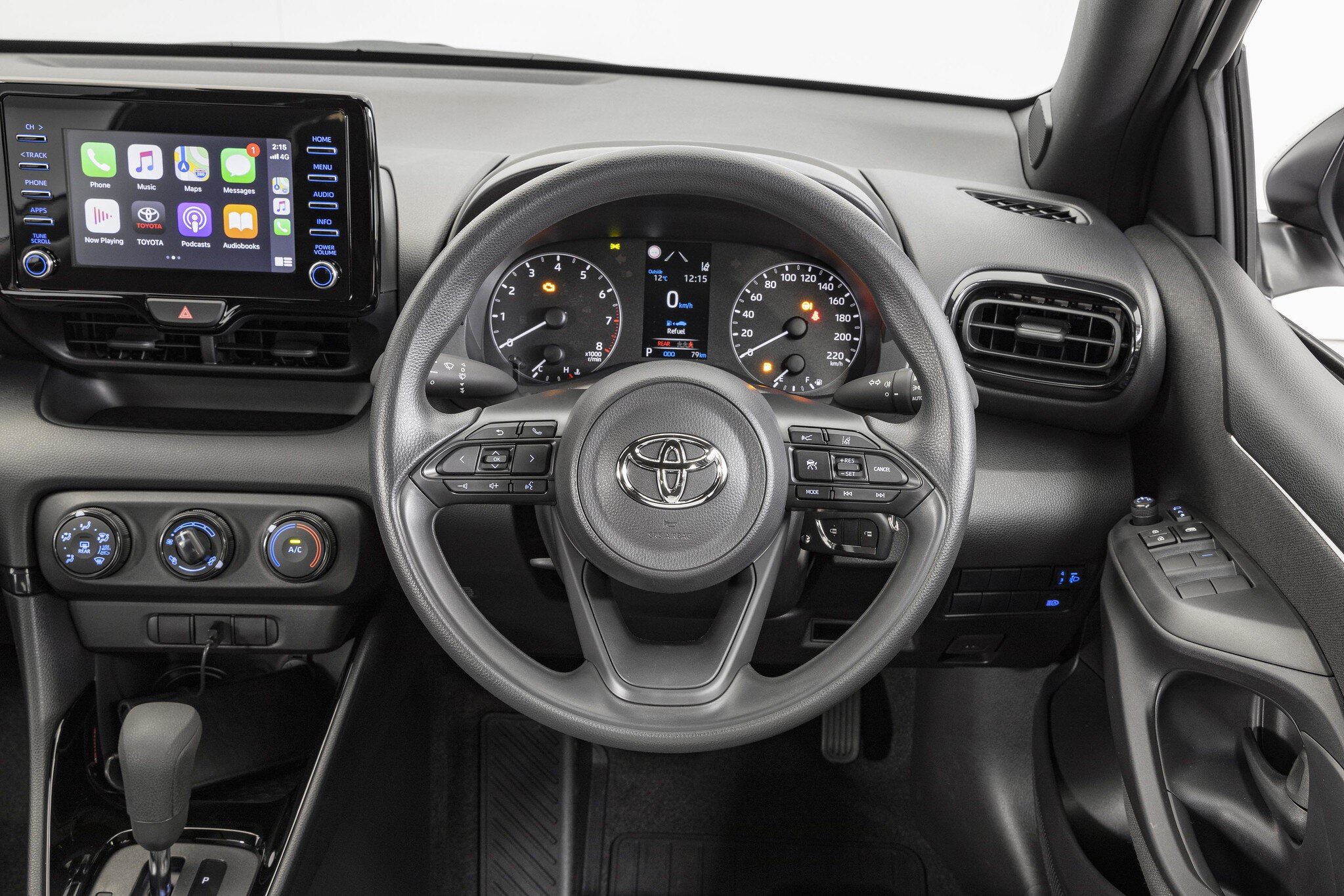

The pre-collision system has also been updated to use a camera, radar and autonomous emergency braking to avoid or mitigate the effects of a crash and it is the first Toyota to gain two collision avoidance systems, delivering automatic braking and steering intervention, previously restricted to some Lexus product.
Aside from detecting vehicles and pedestrians both day and night, and cyclists during the day, the full system is also claimed to detect and automatically brake to avoid other vehicles and pedestrians when turning at intersections. The on-board camera can also recognise speed signs and alert drivers if they’re going above the posted limits and also facilitates a lane-keep function.
The ZR variants also feature blind spot monitor plus front and rear parking sensors that can trigger the brakes to avoid contact.
It is the next Toyota to adopt full smartphone integration including Apple CarPlay and Android Auto. Functionality is via a large, high resolution touchscreen that stands out as one of the high-quality features now in a cabin in which, Toyota says, trims are now more premium.
The GX has a black interior, while the ZR has a contrasting grey and black interior with red accents, both with cloth trims. The ZR has sports style seats, climate control air conditioning, smart entry with push button start, digital speedometer and a heads-up display.

TNZ is promoting this fourth-generation Yaris as being more spacious than predecessors. The front seats have been moved outwards by 10mm to create more space between the driver and front passenger, while the seats are lower in the vehicle also. More storage space has been added in the front console, under the audio unit and in front of the front passenger.
The Yaris and Yaris Cross have the same 2560mm wheelbase, but the hatch is 240mm shorter overall, the crossover adding 60mm to the front overhang and 180mm to the rear, to ensure more interior space. The ground clearance is 60mm higher with the Cross and, with 1550mm height, the hatch is 90mm lower and 20mm narrower overall.
The maker is also asking consumers to take note of the car’s “new energetic and sporty look”. The GX features new 15-inch steel wheels with cover, while the ZR has two-tone machine- finished 16-inch alloys.
Keeping with that theme, the ZR is available in two two-tone options – an ebony roof coupled with either eclectic blue or coral exterior paint options.
The combined effect of the improvements does hit the bottom line, of course. Take note that the outgoing line priced between $23,290 and $27,490 when it launched back in 2012. However, Lala says the impetus has not been to sell Yaris as the cheapest car but as the best; TNZ research also suggests buyers are increasingly looking for more premium features in the choices, and don’t mind paying a little extra for it.

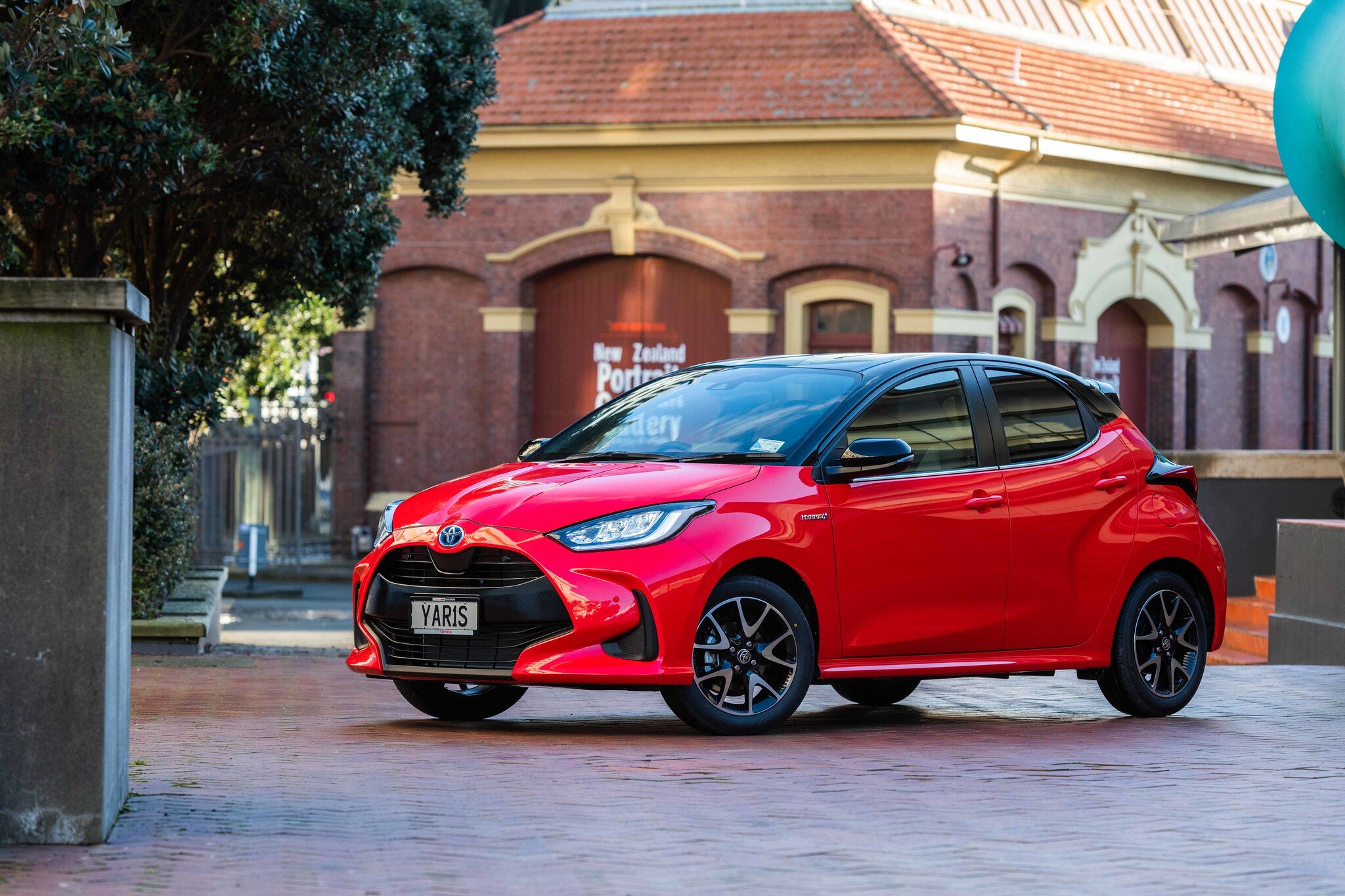
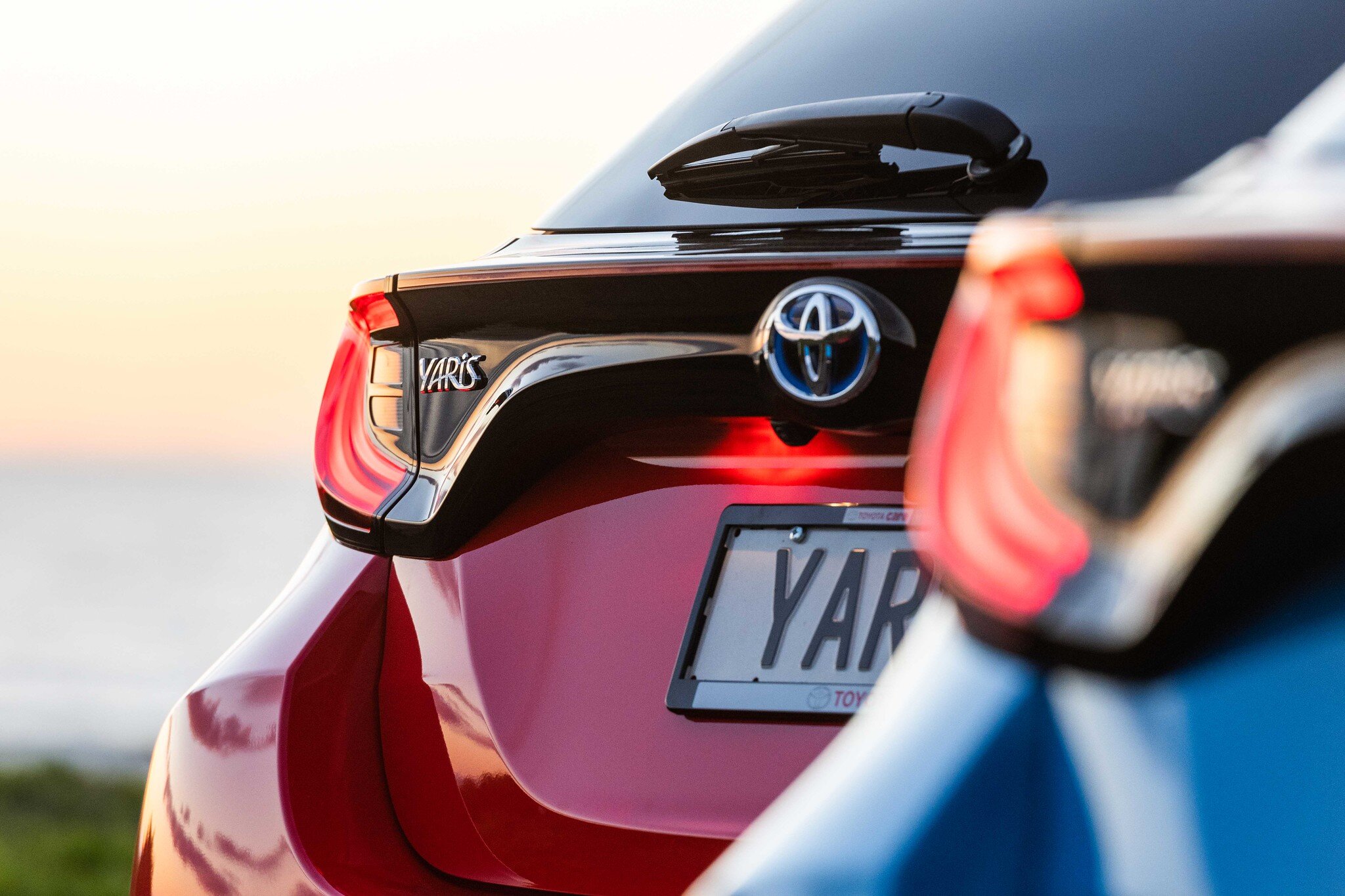
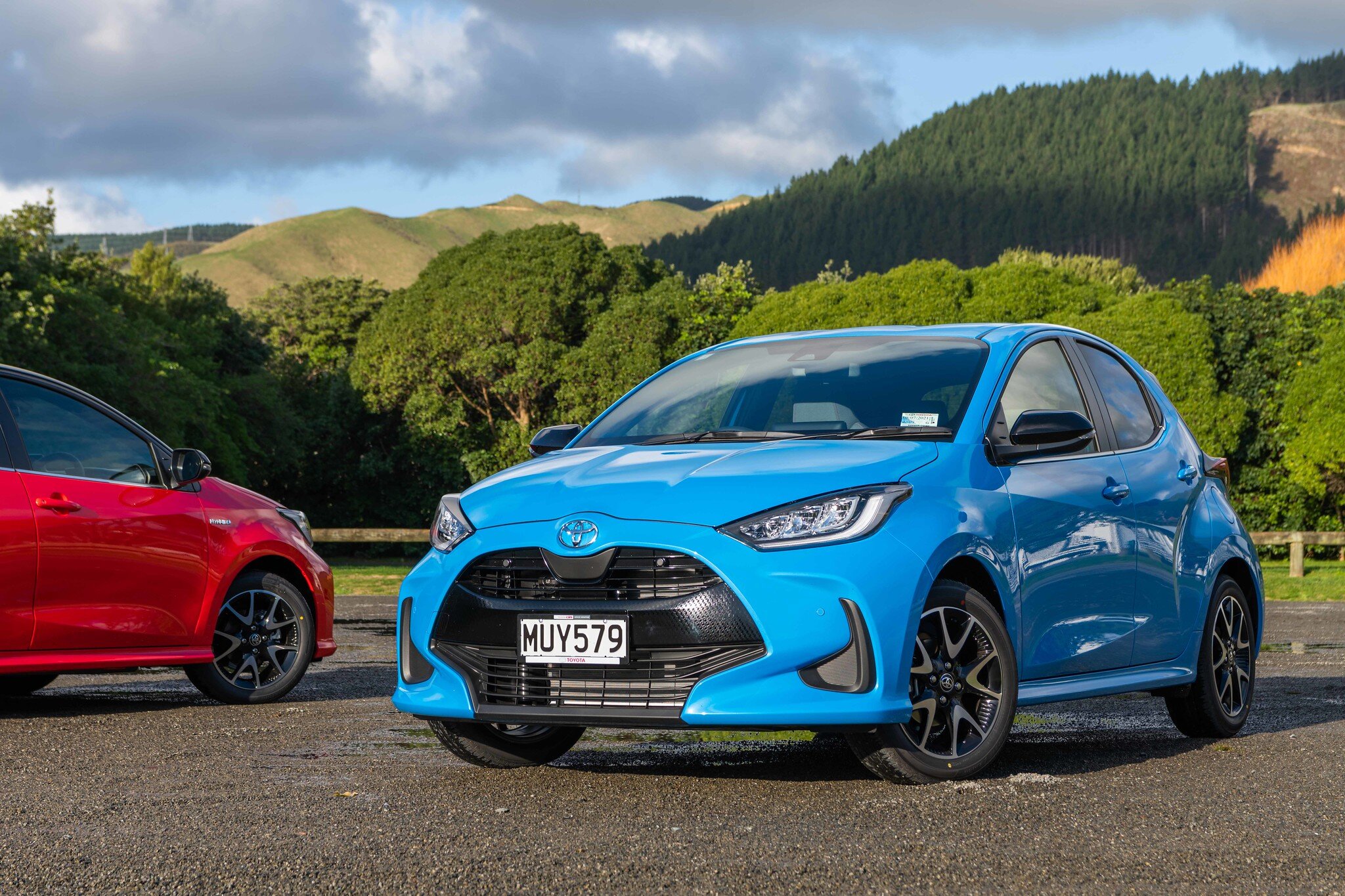

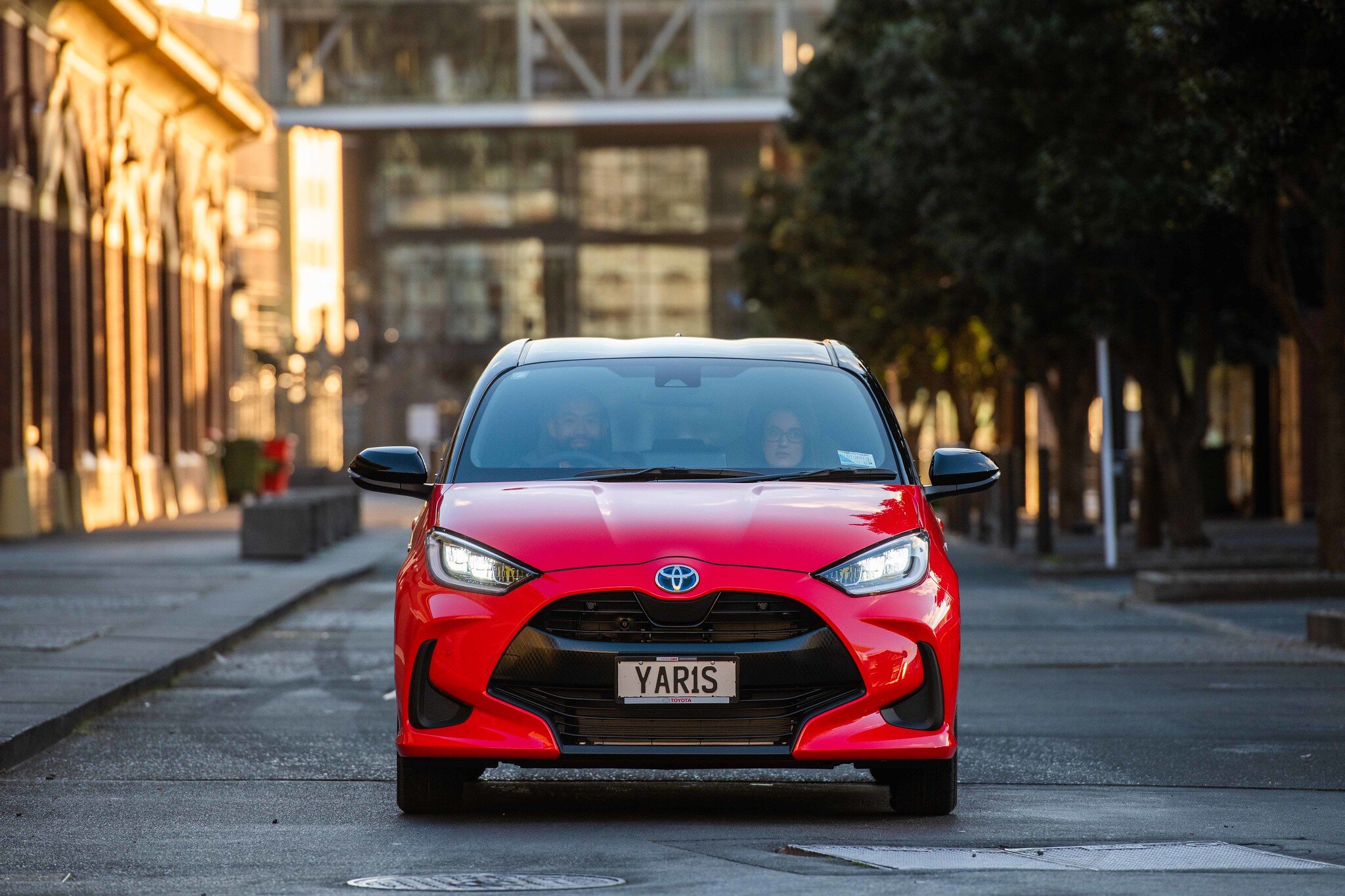
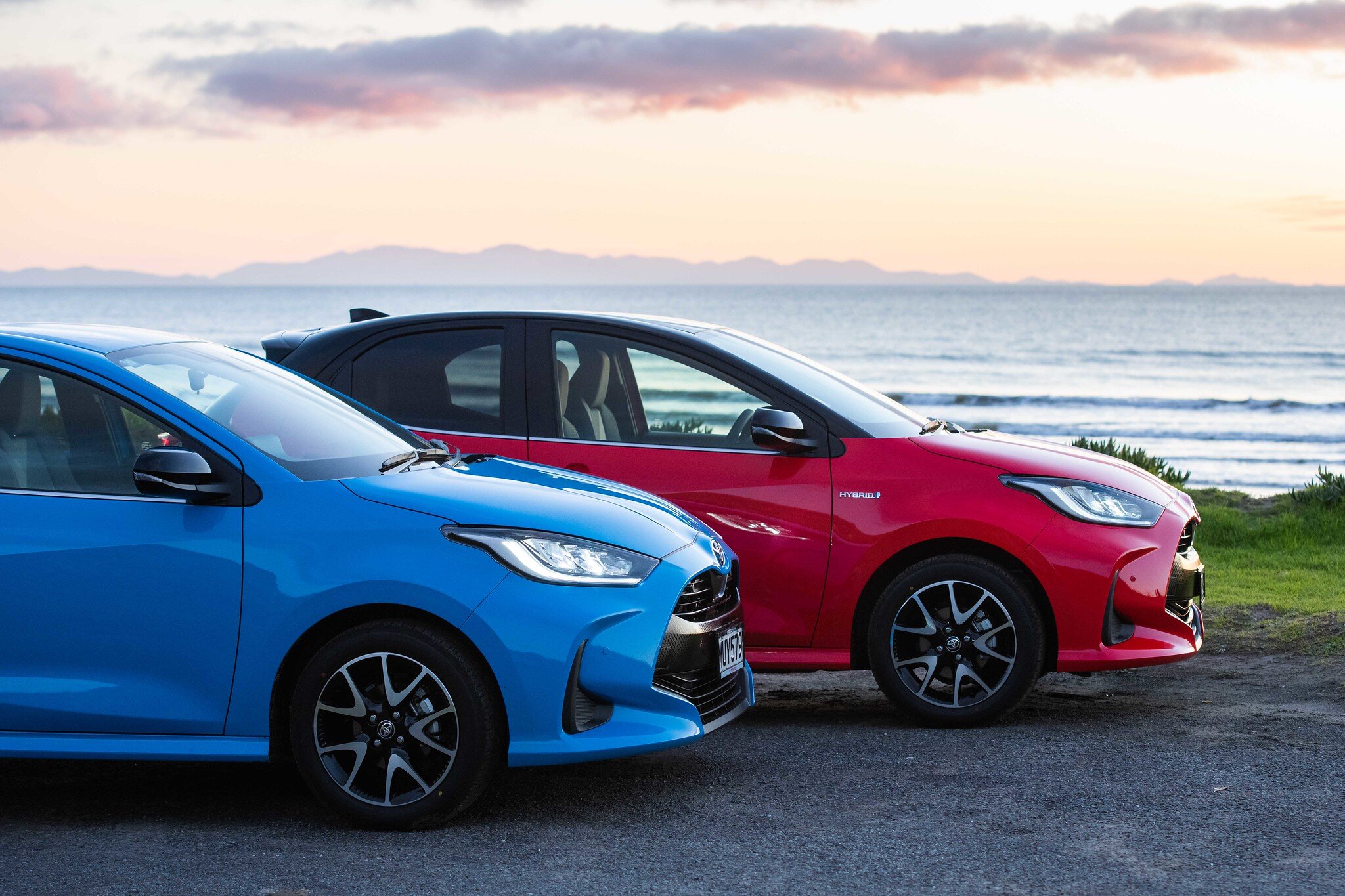
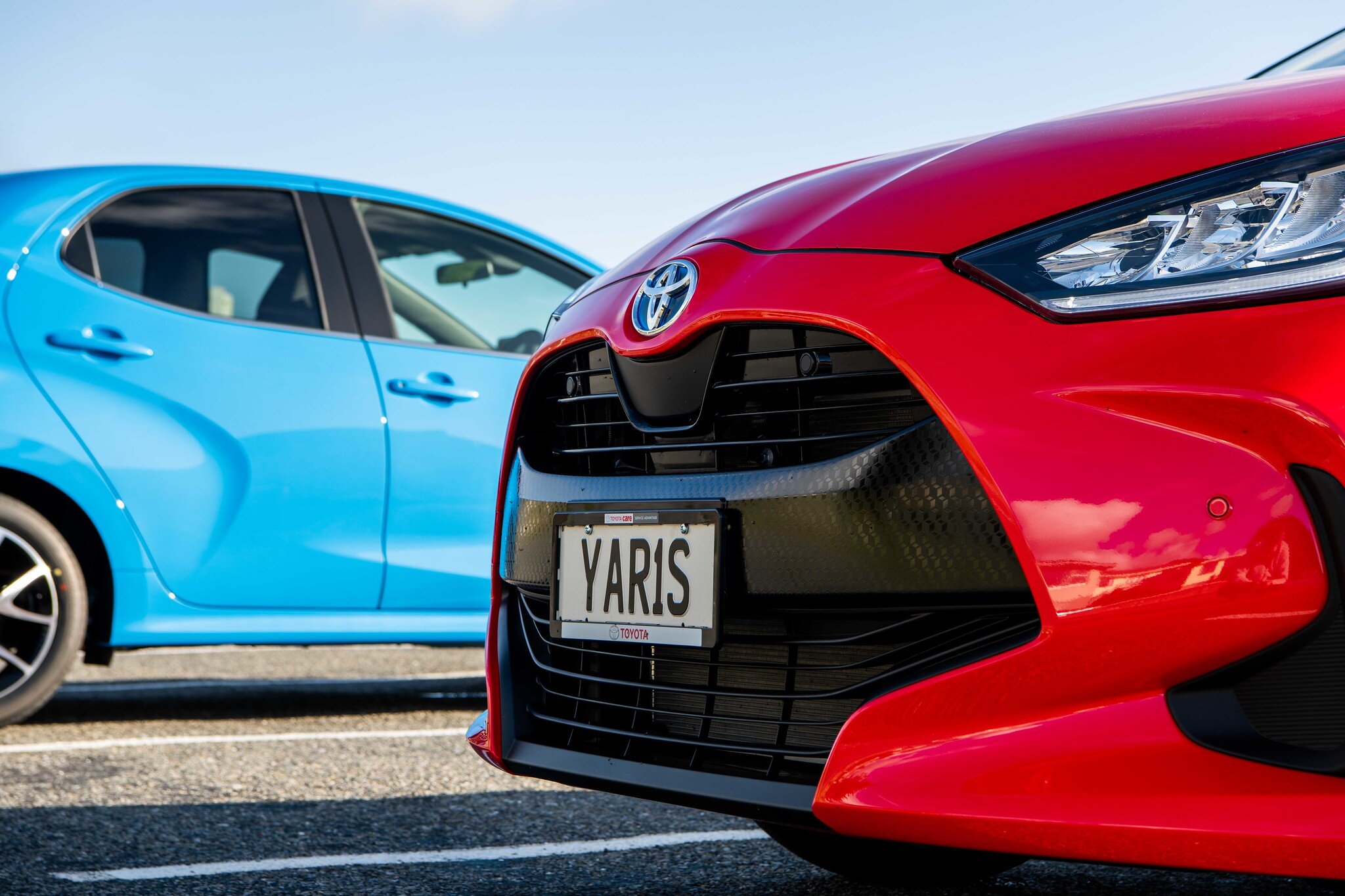

ADVANCE notice of changes coming to the Camry has been given.
A fresh front end styling sits ahead of some key technology improvements that mean an upgrade to the already comprehensive Toyota Safety Sense suite of assists.
What the maker is calling Safety Sense 2.5 includes upgrades to systems such as the pedestrian-detection and adaptive cruise control functions.
The car also takes a new dash design, the big change there being a different touchscreen infotainment set up – it also now a tablet-style arrangement, meaning it sticks out of the dash.
Before we see this, the hybrid drivetrain that has become core to the car’s appeal will be given a refresh.
Retirement of the current 245V nickel metal hydride battery for the 2.5-litre petrol electric drivetrain for a more efficient 259V lithium-ion battery is set to happen very soon, well before the new look arrives.
Which is when, exactly? Well, don’t be in a rush to grill your dealer – as said, though released now, this news about the mid-life restyling process is very much ahead of delivery time. The changes will not chime in until early next year, in fact.
However, with first Toyota in America and then the brand’s Australia outpost having notified the update, Toyota New Zealand has been compelled to speak, with chief executive Neeraj Lala offering the following in respect to the updates and the brand’s thinking about the ongoing status of a car that has been pointed more toward private sector and weaned off fleet and taxi stand favouritism.
“While the sedan/passenger car customer interest does continue to decline, we have seen a significant increase in Camry sales since the launch of the new generation model in 2018,” he offered.
“Our market penetration for private Camry sales is sitting at 30 percent year to date. We are increasingly seeing customers move towards hybrid powertrains across all our models and Camry is no different with 85 percent of our sales year to date.
“We have had great customer feedback on how it is a great car to drive, and people quite literally can’t believe it is a Camry they are driving!”

Alistair Davis, left, and Neeraj Lala.
MARKET-dominant Toyota New Zealand and its prestige Lexus affiliate has a new boss.
Neeraj Lala, at present the Palmerston North-centred brand’s chief operating officer at present, will start work on July 1 in the next step role, as chief executive officer.
In doing so he replaces Alistair Davis, who held the job for 12 years – assuming responsibility from another New Zealander, Bob Field.
Though ostensibly heading into retirement, Davis will follow the same path taken by his own predecessor by retaining a corporate connection, as non-executive chair of the board reporting to Toyota Motor Corporation (TMC) in Japan.
A Wellington-born married man and father of three, Lala has expressed excitement to take the helm as Toyota transitions from being a traditional car maker into a mobility company focused on future technologies.
“It has been a privilege to serve under Alistair’s leadership … and I appreciate his encouragement of my career development at Toyota. Alistair’s focus on people, culture and sustainability is well-embedded in the company and in the leadership team.
“I intend to carry on with that core focus, while advocating for an even better use of data and digital assets to get closer to our customers, particularly in these challenging and competitive times,” he says.
Mr Davis has called his successor a qualified leader who thrives on challenges and has the energy and vision to inspire and lead the company forward into a changed world.
“In Neeraj, Toyota has a well-prepared leader to take the company forward in the post-Covid 19 economy. He is an advocate for new ideas when it comes to how automakers market and sell their products in the 21st century,” he says.
Lala is known for being particularly passionate about performance machines - he drives a 2020 Toyota GR Supra - and technology. These interests mirror those of TMC President Akio Toyoda, who has even raced cars under a pseudonym.
Lala joined Toyota New Zealand in 1988 as an internet development co-ordinator and has since ascended via almost all areas of the Toyota business including marketing, new vehicles, product planning and used vehicles.
In 2014, he added to the Bachelor of Commerce from Victoria University held when he began employment by completing an Executive Master of Business Administration (MBA), finishing top in his class with distinction.
Between the end of 2014 to 2018 he undertook an executive leadership programme with Toyota Motor Sales in the United States, basing in California.
Since then he has been instrumental in driving transformational change at Toyota.
Mr Davis declined opportunity to be interviewed about his own period of tenure, citing preference for media attention to go to his replacement.

LOANING cars to struggling businesses potentially helps the country’s biggest brand ease a headache Covid-19 might hardly improve.
Toyota New Zealand’s intent to provision 100 Highlander sports utility vehicles to small businesses nationwide for a year’s free usage comes with a caveat it has been happy to discuss. To a point.
Though current models, small print with the Small Business Driver package clearly relates the 3.5-litre V6 seven-seaters in mid-level GXL trim are not as might be imagined: Brand-new examples of this $58,490 car.
What’s on offer is stock first registered in 2018 and likely to have 30,000km to 45,000km on the clock, apparently accrued from toting tourists.
Plucked from the in-house Signature Class used vehicle processing programme, the Highlanders are from what is perceived within the broader industry to be a massive count of vehicles laid up in what could be called TNZ’s ‘ghost fleet’.
Which is? A raft of mainly ex-rentals the market leader has acquired through buy-back agreements far less common now and then parked up for months … perhaps years.
This the result of TNZ having been unable to push them through used car channels en mass, for fear of causing a glut that might collapse used car prices.
Instead, they sit inactive in what has been derisively called, by rival brands, a ‘rental swamp’. Holding yards and warehouses. Some there for so long that – according to talk - registrations have retired, batteries depleted and tyres squared.
Industry lore relates enough vehicles are in a limbo to likely be costing the brand many thousands of dollars annually in upkeep and storage fees. Can that be true?
TNZ has been asked on numerous occasions, including during compilation of today’s story, to offer clarification. Every request has been met the same way. With silence.
As much as chief executive officer Neeraj Lala was happy to share his enthusiasm about the loan scheme – which is, beyond doubt, a very generous opportunity – he declined to deal with a host of follow-up questions relating to the cars’ provenance and the state and size of the stockpile.
The finer details of what’s on offer currently were passed on by a potential applicant who, while a little surprised by the cars’ suggested histories, was not particularly perturbed.
“A free car is a very generous offer, no argument. As it turns out, I don’t qualify because another of the stipulations is that you have to be a recipient of the Government’s wage subsidy, but it’s a good concept.”
An industry involver spoken to subsequently also thought the idea was interesting.
“It’s a rental swamp and the swamp needs draining ... this is what has to be done.
“They’re probably not making anything on it. But it at least gets some vehicles back on the roads and free of storage fees that, while quite cheap on a per day per car basis, soon adds up to a chunk of change when you’re talking big counts for long term.”

‘Buy-back’ was said to be a core ingredient of when Toyota basically sought to corner the national fleet business, which some years accounts for up to 80 percent of new car sales.
Since 2018 TNZ has sought to swing its focus back to private buyers with its Drive Happy programme that aims for fair pricing and says it has detuned the intensity and scale of its fleet push.
Even so, it still agrees to discount to large-scale purchasers and, as a glance around any airport carpark (at least pre-Covid) would confirm that, while other brands have come back into hirer circles, there are still a lot of Corollas, Highlanders and RAV4s behind those rental placards.
And 2018 appears to have been the last big year, with industry statistics showing 1660 Highlanders having gone into rental, whereas just 179 followed last year. The majority were GXL variants.
Now, of course, there’s coronavirus, which has certainly dented the car trade and is doing those brands supplying rental providers no favours.
Distributors have been pressured to take back stock – often in as-new condition - now standing idle and waive delivery of incoming product.
That’s a big ask: June has historically been a big month for rental car fleet replenishment to cope with the tide of winter tourists. TNZ indicated recently it is challenged by this; it doesn’t want to upset core corporate clients, but neither can it afford to assume responsibility for pre-agreed consignments.
With the Highlanders, it’s not quite a matter of first in, first served: Only small businesses with fewer than 20 employees are eligible and applicants are vetted by a selection panel.
The scheme has been created in conjunction with MediaWorks, and includes a share of $1 million of advertising with the media company for successful applicants.
Those interested in applying have until 11.59pm on June 9 to apply.
Perhaps, at the end of the exercise, users might receive tasty opportunity to purchase the vehicles outright.
Of course, they have to weigh up the deal against the fuel costs. The V6’s taste for petrol is a core reason why the next-generation Highlander, coming next year, will only be offered as a four-cylinder hybrid.
MotoringNZ reviews new cars and keeps readers up-to-date with the latest developments on the auto industry. All the major brands are represented. The site is owned and edited by New Zealand motoring journalist Richard Bosselman.